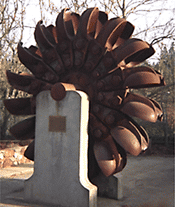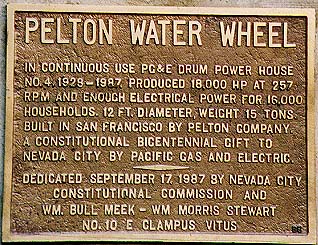|
(35a) Planetary Gravity-Assist and the Pelton Turbine
|
|
-------------------------- ------------------- Solar Shocks |
Lester Pelton The way in which a spacecraft increases or decreases its kinetic energy by swinging around a moving planet is very similar to the way a certain type of water turbine, the Pelton Wheel, extracts energy from a fast jet of water.
The way in which a spacecraft increases or decreases its kinetic energy by swinging around a moving planet is very similar to the way a certain type of water turbine, the Pelton Wheel, extracts energy from a fast jet of water.Lester Pelton, the inventor of the device, was born in 1829 in Vermillion, Ohio, on the shores of Lake Erie. In 1850 he arrived in California among the gold rush migrants and became a fisherman on the Sacramento river. Around 1853 he gave up on fishing and started working in the gold mines of Camptonville, Nevada City and Grass Valley, on the Yuba river in the "mother lode country." In 1864 he became a carpenter and millwright. By that time the search for gold had progressed from sifting creek gravel ("placer mining") to processing large amounts of ore--from gravel deposits on the surface and from hard-rock mining. This required power--to drive stamp mills that crushed the ore, to pump air into mine tunnels and later to provide electricity and compressed air. Some mines used steam engines, but these needed a large and constant supply of firewood. Mountain creeks could also supply energy, but the amount of their water was rather limited, although it fell from great height. Therefore, instead of the slow (and inefficient) water wheels traditionally used by flour mills, which needed only a moderate height but used a large amount of water, mine owners installed turbines--wheels with cups around their circumference, on which a fast jet of water was directed, coming from a high-up reservoir.
|

Planetary gravity-assist,
|
 |
| Action of the Pelton wheel |
Total energy is always conserved. Neglecting friction losses (which are converted to heat), the kinetic energy lost by the jet is converted to additional rotational energy of the turbine wheel, speeding up its motion, or perhaps helping run machinery connected to it. By adjusting the speed of the jet to be equal to twice the speed of the vanes, almost all of the jet´s energy can be converted into useful output.
-
[A problem with the De-Laval turbine is that cannot easily attain this condition. Though the steam jet converts heat energy very efficiently, to efficiently extract energy from it, the turbine wheel should match half the jet's velocity. But the jet's speed is more than the velocity of sound; if it moves at (say) twice the speed of sound, the periphery of the wheel should be moving at the speed of sound, which is too much for machinery.
Modern steam turbines use several sets of blades. The first set extracts only part of the energy, and the jet coming out of it is still quite fast. Since the jet now moves in the opposite direction, it must be reversed before it can give more energy to the second blade in line. That is done by a set of stationary blades, firmly attached to the housing of the turbine. As in case #2 above, such blades take away none of the energy.]
Through the later 1870s Pelton developed his design, settling in the end on a double cup with a wedge-shaped divider in the middle, splitting the jet--half to the left, half to the right. (You can approximate that design by cupping your hands upwards, then bringing them together, with the fingernails of one hand touching the ones of the other.) In the winters of 1877 and 1878 he tested turbines of different sizes, including a small one for running his landlady´s sewing machine (it worked, but he was not happy with the design). In 1880 he also obtained a patent on his invention.
Pelton then tried to sell his turbines, but met with little success until the spring of 1883, when the Idaho Mining Company of Grass Valley in Yuba County, California, arranged a competition between different designs, before deciding which design it would buy. Pelton´s turbine won by reaching an efficiency of 90.2%, whereas the three competing water wheels only attained 76.5%, 69.6% and 60.5%. After that sales grew at a tremendous rate, and in 1888 Pelton with some partners formed in San Francisco the Pelton Water Wheel Company, which expanded production even more.

While Pelton´s turbines were installed all over the world, some of his best customers were right in the "mother lode country" where he began his career. The biggest Pelton wheel ever built measured 30´ across and is now on display in Grass Valley, while a 15-ton wheel, on view in nearby Nevada City (its image at the beginning of this section and its memorial plaque is portrayed above), provided 18000 horsepowers of electricity for nearly 60 years. Pelton ultimately moved to Oakland, on San Francisco Bay, and died there in 1908. He never married.
|
Purely for humorous wasted time, look up who put up the plaque--named on bottom line. Questions from Users: *** Pelton Wheel Efficiency
Author and Curator: Dr. David P. Stern |
